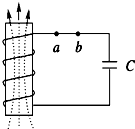问题
选择题
| 如图所示的LC振荡电路,在某时刻的磁场方向如图所示,则下列判断不正确的是( ) A.若磁场正在增强,则电场能正在减少,电容器上极板带正电 B.若磁场正在减弱,则电场能正在增强,电容器上极板带正电 C.振荡电流的变化周期为:2π D.电场能量的变化周期为:π  |
答案
答案:A
| 如图所示的LC振荡电路,在某时刻的磁场方向如图所示,则下列判断不正确的是( ) A.若磁场正在增强,则电场能正在减少,电容器上极板带正电 B.若磁场正在减弱,则电场能正在增强,电容器上极板带正电 C.振荡电流的变化周期为:2π D.电场能量的变化周期为:π  |
答案:A